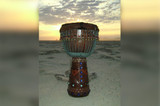Inspiration and Imitation – Learning the Bongos
Imitation may be the highest form of flattery, but it also serves another purpose for drummers and percussionists. By imitating the great Bongoceros in Latin and other world music, a bongo drummer can learn timing, technique and gain the necessary skills that help with improvisation and the creation of unique and personal rhythmic styles.
Bongo rhythms can be complex, encouraging timing that varies with each hand in order to lead and enhance the Latin feel in Son, Cuban Jazz, Salsa and Rumba music. Much of the music from Cuba evolved from Clave, a versatile rhythm based on a five-stroke pattern that adds a syncopated, upbeat feel to the music. Clave is written in 12/8 time, but can be adapted to a 4/4 rhythmic pattern, fitting both the son clave and rumba clave patterns, both of which can easily be played on the bongos. It is this basic rhythm that even the most seasoned bongoceros can return to while adding fills and solos.
The clave and other bongo rhythms can be easily heard in the music of such artists as Jack Constanzo, José Mangual Sr. or Pedrito Diaz. These bongoceros are some of the most widely influential performers in Latin music and are known around the world for their incredible talent and skill. In order to really understand the intricacies involved in playing Salsa, Cuban Jazz and other Latin music, listening and playing along to these bongo greats can help establish a foundation for playing the bongos, and the spirited style crucial to a show-stopping performance.
Through practice, imitation and determination, a beginner bongocero can hone raw drumming talent into a life-long love and appreciation of the bongos. These percussion instruments, seen as a staple in music classes, drum circles and recording studios, require more than an affinity for drumming, but the passion and determination to play them to their fullest potential. Through imitating the great bongoceros and studying the styles and origins of Latin and Cuban music, bongo rhythms and playing can become second nature, flavoring all types of music with the upbeat sound and tones of the bongos.
Recent Posts
-
What is the Best Size Djembe for Beginners?
If you're new to the world of percussion and interested in learning the djembe, you're in for a t …16th Jul 2024 -
The Benefits of Becoming a Drumming Teacher: Transforming Passion into Profession
Why become a drumming teacher? Becoming a drumming teacher is an excellent way to share your pas …22nd May 2024 -
What Makes the Djembe Drum a Spiritual Instrument in African Music?
Origin and history of the Djembe drum The Djembe drum originates from West Africa and holds sign …16th May 2024



